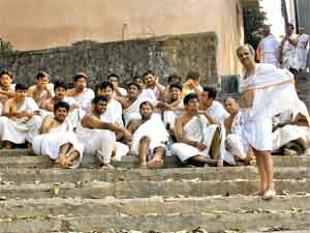The giant statue of goddess Saraswati at the centre of a courtyard of a village school and the Sanskrit signboard outside the gate is the perfect prologue to this story. Children studying at the Mattur school in Shimoga in Karnataka are taught the Vedas once they turn 10 and all the students who come from the village speak Sanskrit fluently. To the casual visitor, Mattur fits the word “idyllic.” Arecanut trees and lush fields make way for a smooth road to the village, which is a cluster of simplistically finished and tightly packed concrete houses.
For the last 600 years, the Sankethis, a community of Brahmins that migrated from Kerala, have been living together and leading an insular way of life. Daily life revolves around Sanskrit. Aham Gacchami (I am going) and other expressions in the ancient language can be heard on the street. Since the language is spoken by people wearing jeans and t-shirts or while talking over a cell phone or riding a motorbike, Mattur has become a quaint metaphor for ancient India in modern times.
Most residents of the village are happy that the Narendra Modi government plans to replace German with Sanskrit in CBSE schools. “Of course, children in India must necessarily study Sanskrit. The Vedas can help children lead fuller lives as they teach about how to lead a better family life, to understand the metaphysical aspect of life and so on,” says Madhukar, who resigned from his job at Cisco as a software engineer and returned to the village to set up a garments business.
Almost every house in this Brahmin village has an IT professional and many of them are working abroad. The Sankethis are proud of their culture and almost every NRI makes it a point to attend rituals and festivals back home.
The crime rate is extremely low, given that the village by itself is one extended family. “There is not a single property dispute pending before courts from this village. We have a culture of cohesion that has been around for generations and we have managed to keep it going,” says Yadu, who, like Madhukar, goes by one name and is a software professional.
Not All Are Welcome
It was only last year that, for the first time, a boy from one of the families here married a girl from north India. Until then, the community thrived on marrying within and, at the most, into Brahmin families from nearby areas. The local attitude towards the marriage to the ‘outsider’ is predictable: Many of the local residents are yet to come to terms with the marriage and have stopped visiting their home.
“This family is rich and that is why they dared to break tradition. If any of us commoners were to break tradition, there would be hell to pay,” says a teacher at the school. There is also a sense of fear at the prospect of getting cut off from the rest of the society and many of the youngsters want the castebarriers lifted at the least.
n Mattur, there is a huge gap between the elders and the younger lot in terms of the ideal way of life to be pursued. The elders of this patriarchal society want a strict enforcement of caste norms and it is acknowledged that even today bringing a guest from another caste could be frowned upon.
“I have had to face many embarrassing moments after I brought friends from other castes home. My mother would not like it. I understand we need to change but the elders need time. They cannot change so fast,” says a young software professional from the village who did not wish to be identified. “The community is too rigid. We cannot afford to be cut off for so long,” says Prafulla MS, a Sanskrit teacher at the local school. She adds that the growing inequality between the rich and poor was also causing some consternation.

